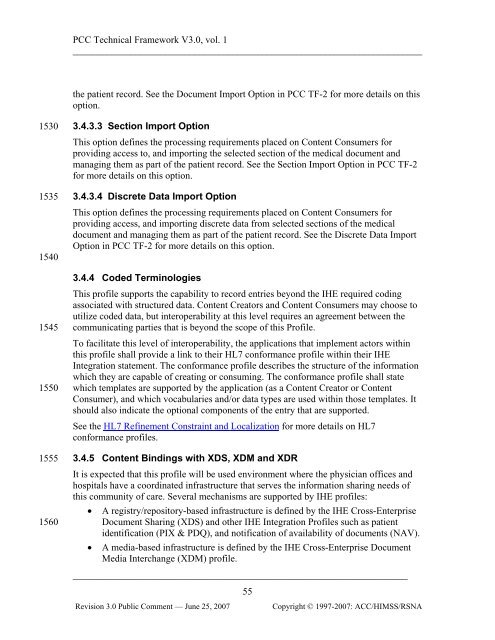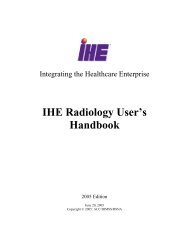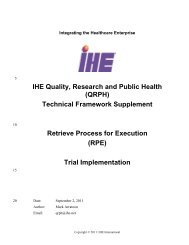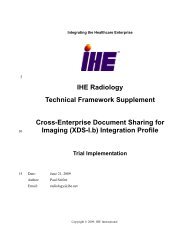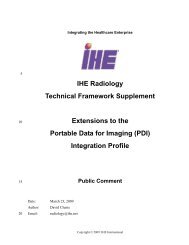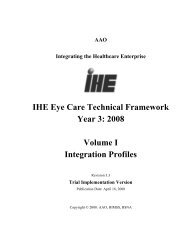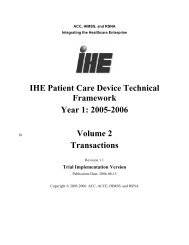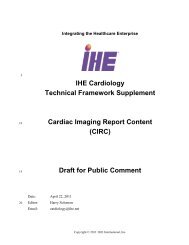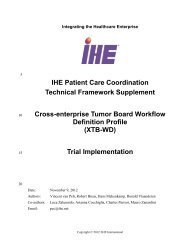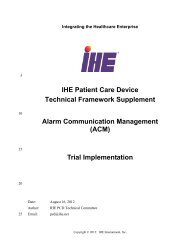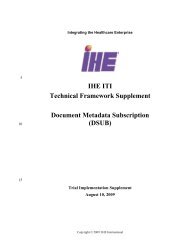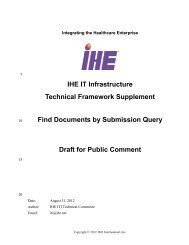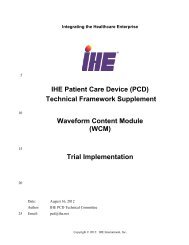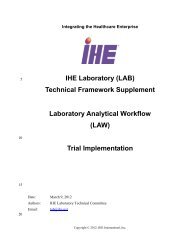IHE Patient Care Coordination Technical Framework Vol I
IHE Patient Care Coordination Technical Framework Vol I
IHE Patient Care Coordination Technical Framework Vol I
Create successful ePaper yourself
Turn your PDF publications into a flip-book with our unique Google optimized e-Paper software.
PCC <strong>Technical</strong> <strong>Framework</strong> V3.0, vol. 1<br />
________________________________________________________________________<br />
the patient record. See the Document Import Option in PCC TF-2 for more details on this<br />
option.<br />
1530<br />
1535<br />
1540<br />
3.4.3.3 Section Import Option<br />
This option defines the processing requirements placed on Content Consumers for<br />
providing access to, and importing the selected section of the medical document and<br />
managing them as part of the patient record. See the Section Import Option in PCC TF-2<br />
for more details on this option.<br />
3.4.3.4 Discrete Data Import Option<br />
This option defines the processing requirements placed on Content Consumers for<br />
providing access, and importing discrete data from selected sections of the medical<br />
document and managing them as part of the patient record. See the Discrete Data Import<br />
Option in PCC TF-2 for more details on this option.<br />
3.4.4 Coded Terminologies<br />
1545<br />
1550<br />
1555<br />
1560<br />
This profile supports the capability to record entries beyond the <strong>IHE</strong> required coding<br />
associated with structured data. Content Creators and Content Consumers may choose to<br />
utilize coded data, but interoperability at this level requires an agreement between the<br />
communicating parties that is beyond the scope of this Profile.<br />
To facilitate this level of interoperability, the applications that implement actors within<br />
this profile shall provide a link to their HL7 conformance profile within their <strong>IHE</strong><br />
Integration statement. The conformance profile describes the structure of the information<br />
which they are capable of creating or consuming. The conformance profile shall state<br />
which templates are supported by the application (as a Content Creator or Content<br />
Consumer), and which vocabularies and/or data types are used within those templates. It<br />
should also indicate the optional components of the entry that are supported.<br />
See the HL7 Refinement Constraint and Localization for more details on HL7<br />
conformance profiles.<br />
3.4.5 Content Bindings with XDS, XDM and XDR<br />
It is expected that this profile will be used environment where the physician offices and<br />
hospitals have a coordinated infrastructure that serves the information sharing needs of<br />
this community of care. Several mechanisms are supported by <strong>IHE</strong> profiles:<br />
• A registry/repository-based infrastructure is defined by the <strong>IHE</strong> Cross-Enterprise<br />
Document Sharing (XDS) and other <strong>IHE</strong> Integration Profiles such as patient<br />
identification (PIX & PDQ), and notification of availability of documents (NAV).<br />
• A media-based infrastructure is defined by the <strong>IHE</strong> Cross-Enterprise Document<br />
Media Interchange (XDM) profile.<br />
_____________________________________________________________________<br />
55<br />
Revision 3.0 Public Comment — June 25, 2007<br />
Copyright © 1997-2007: ACC/HIMSS/RSNA


